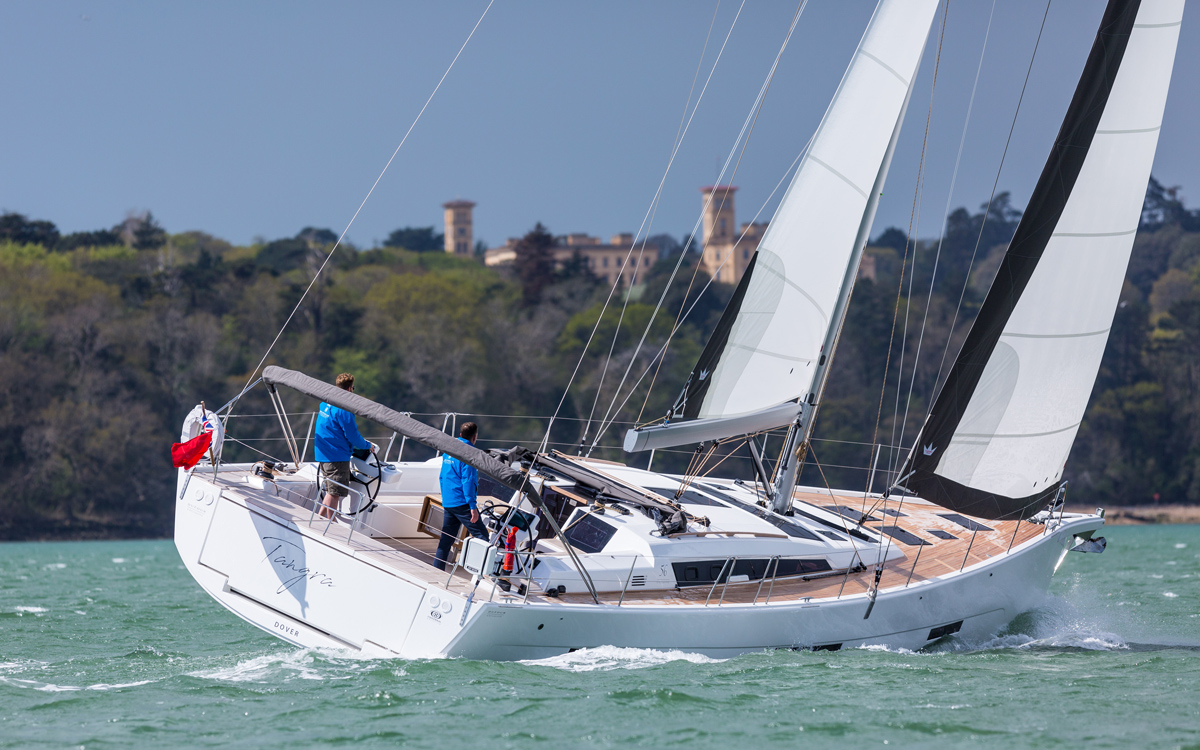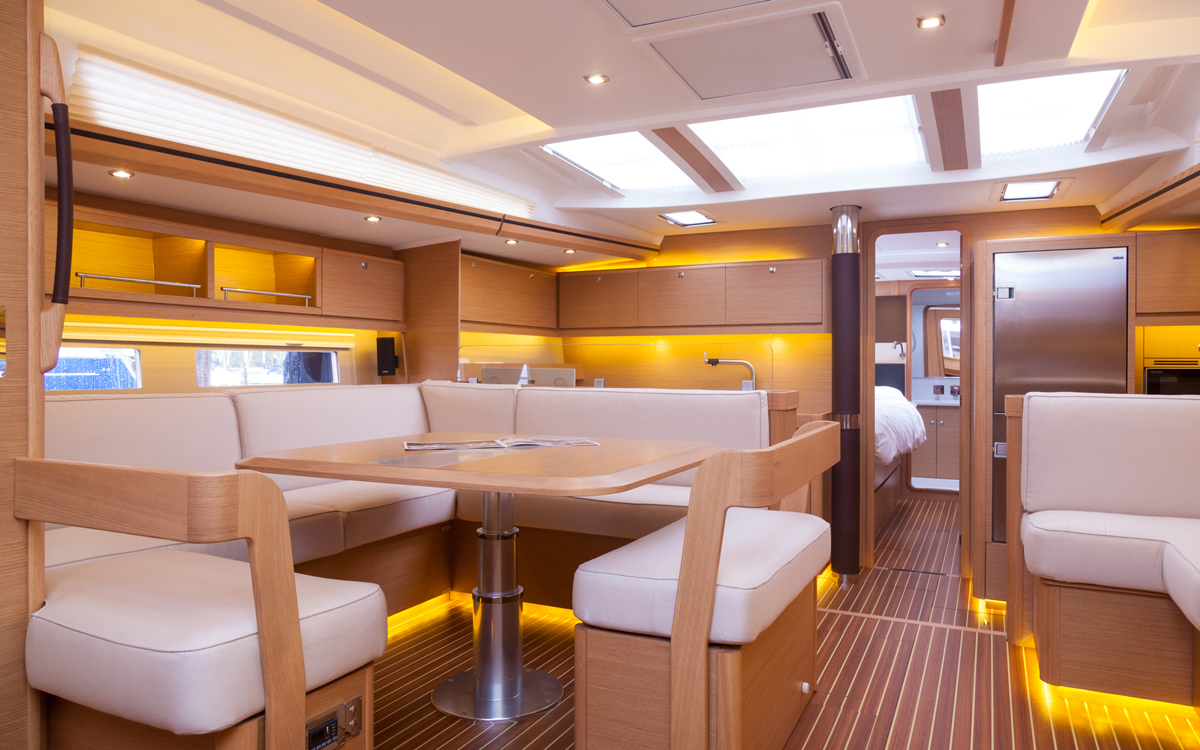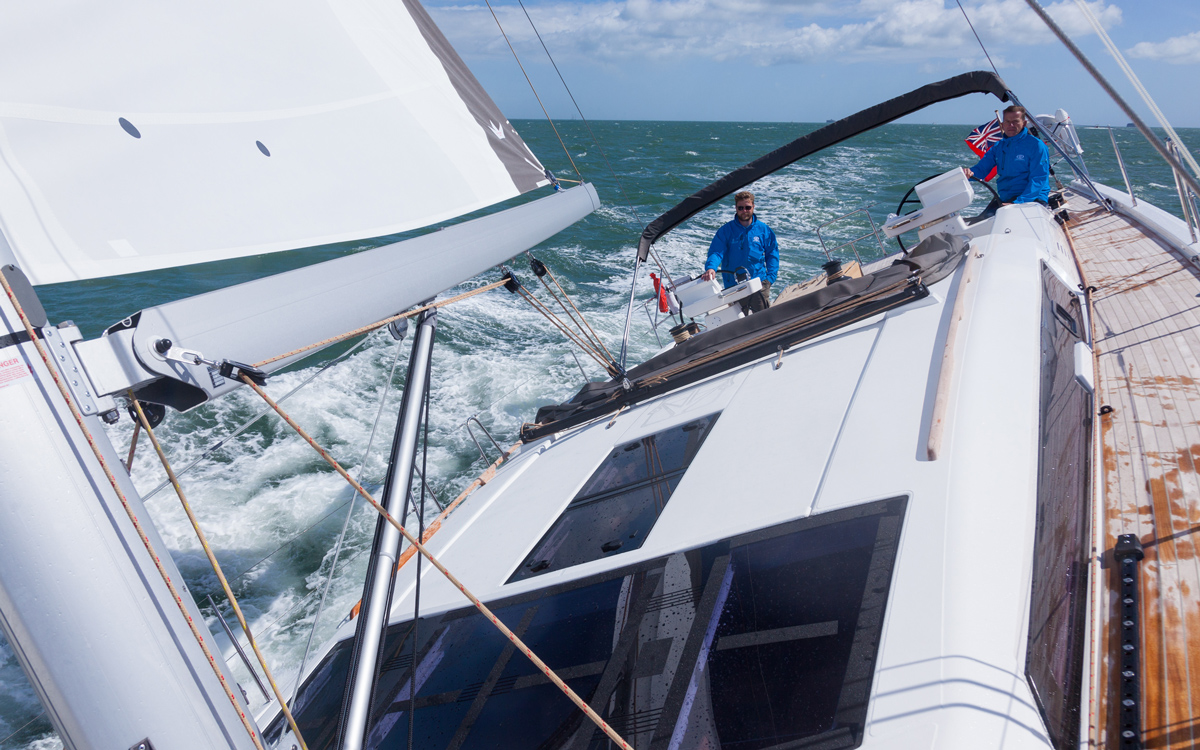Does Dufour’s revamped 560 live up to its ‘Exclusive’ badge? David Harding reports from a Solent sea trial on board the Dufour 56 Exclusive
In some respects, Dufour yachts used to be a bit like the early Citroën cars: different, slightly quirky and created by people with firm beliefs and a clear passion for what they were doing.
In recent years they have arguably become more mainstream, though when you blend French pedigree with Italian design and styling you’re unlikely to end up with anything plain or boring.
Dufour’s new 56 Exclusive looks anything but plain or boring. It simply oozes French-Italian chic and, despite conforming to the template of the modern, high-volume production cruiser, it does so in its own way.

Contouring in the topsides above the hull ports is one of many subtle refinements on the new Dufour 56
I discovered this on a day of testing when we experienced everything from bright sunshine, 15 knots of breeze and flat water to torrential rain squalls, a hailstorm, winds nudging 30 knots and the sort of wind-over-tide chop that’s a speciality of Cowes Roads.
It wouldn’t be spoiling the story to say that the new Dufour took it all in its stride, as you would hope. After all, if a boat of this size made heavy weather of a brisk day in the Solent, something would be seriously amiss.
What it did was to demonstrate that Dufour has successfully tweaked and refined the Grand Large 560, first launched in 2014. The changes are mostly detailing and styling, following suggestions by owners and bringing the boat right up to date. In its new guise, the 56 and its 63ft sister now form the ‘Exclusive’ range at the top of Dufour’s line-up, which starts with the 310 and also includes the Drakkar 24 daysailer. A Grand Large 390 has just been announced too.
Old and new
Dufour has been one of the best-known names in production boatbuilding for half a century, since Michel Dufour’s Arpège Safari famously won the Half Ton Cup in 1967. More recently, however, the details have become a little hazy for many people – so what has been happening?
Article continues below…
Hanse 548 review: The push-button 50-footer that can be sailed by a couple
Imagine putting a cruising couple from the late 1990s into a time capsule and fast-forwarding them to the present. Then…
Jeanneau 54 boat test – a sturdy cruiser with hidden depths
Powerful gusts dispersed plumes of spray from the bow, making the whitewater explosions appear even more dramatic as the Jeanneau…
The company was bought by Cantieri del Pardo (Grand Soleil) in 2001. Umberto Felci’s introduction as designer added further to the Italian influence, though production remained in La Rochelle even during the later and relatively brief ownership by Bavaria. Now back in Italian hands following a management buy-out in 2013, Dufour has since then continued to extend its size range upwards.
Building ever-bigger boats is what many production yards are doing because, as we saw in our test of the Hanse 548, owners are increasingly buying models of 50ft and above to do what earlier generations did with their 30-footers.
Like its competitors, the Dufour 56 is designed to make life easy and to appeal to those new to sailing: although those of us who spent our childhoods messing around in dinghies and small cruisers might take a while to get our heads around it, these 50-something-footers are increasingly being bought as first boats. To a large extent that’s because they’re becoming so easy to handle, often with self-tacking jibs and most of the sail-handling manageable from the cockpit with the help of electric winches.
Not so very long ago, cruisers over 35ft (10.5m) or so were widely seen as offshore yachts. If you wanted to hop around the coast or across the Channel there were lots of smaller choices, including many that were broadly in the style of big dinghies, so the 35s and above would often have bullet-proof masthead rigs with in-line spreaders, sometimes a second mast to divide the sail area into easily managed portions, hulls that were deep and narrow, modest freeboard, relatively long keels, small portholes, heavyish displacement, and interiors with lots of bulkheads for rigidity and pillar handholds so you wouldn’t be thrown around too far in a seaway.
Now look at a boat such as the Dufour 56. It has a beamy, shallow-sectioned hull with broad aft sections and generous freeboard, a bolt-on iron fin keel, a fractional, swept-spreader rig with most of the area in the mainsail, a wide, open and relatively shallow cockpit and, by traditional standards, an extraordinarily light, roomy, wide open interior with an array of large ports and opening hatches.
And it’s on the light side even by the standards of modern cruisers, its 17.5 tonnes giving a displacement/waterline ratio of just 143 although the modest rig keeps the sail area/displacement ratio below 20.
Scaling up
The simple fact is that, like smaller designs, many boats of this size have become big dinghies. In some respects that’s no bad thing.
Beamy hulls mean spacious accommodation, high freeboard keeps the coachroof low and flat for generous sun-lounging space, and lightish displacement ensures respectable performance with a modest amount of sail provided the wetted area is kept under control.
While such boats might not be the first choice of every bluewater sailor, they’re increasingly being seen in the various ARCs and rallies and, when not sailing off into the sunset, they usually make much handier and more welcoming weekend cruisers and cottages for families and friends than do more traditional offshore cruising yachts.
Looking more closely at the Dufour 56, we see that it has a fine entry, a shallow forefoot, maximum beam carried almost to the transom, an L-keel giving a draught of 8ft 2in (2.5m), a respectably large rudder, and a chine running to the stern from about two-thirds of the way aft. It almost goes without saying that there’s a plumb bow and, at the other end, a hinge-down transom giving access to a garage for a tender.
Above deck, the rig is supported by just two sets of swept spreaders. Where it departs markedly from the norm is in the low gooseneck. Barely chest high for someone 6ft tall, it makes handling a conventional mainsail possible for many people with no need for mountaineering.
We were unable to experience this as our test boat had in-mast reefing. Both the main and the standard self-tacking jib were in Dacron and from the Elvstrom loft in France, the main being without battens since Z-Spars has always advised against them with its in-mast reefing.
To get the boat going at its best, you would want to replace the Dacron sails with laminates and/or opt for a conventional mainsail. A taller rig in carbon is an option too.
Given the conditions on the day of our test, the reduced area of the in-mast main with its hollow leech made little difference upwind even if its shape was inevitably compromised.
With more than 20 knots across the deck much of the time, we were fully powered up to the extent that we wound in a few rolls during the course of the day and then some more while attempting to skirt around the edge of a particularly black rain squall. We wound in some jib too, which is never a way to see a self-tacker at its best.
Happy at the helm
Given the in-mast reefing, the Dufour 56 seemed to be up to the mark in terms of performance. The log on our test boat gave very different readings on each tack, averaging between 7.5 and 8 knots upwind depending on the wind speed and sea state.
Sailing was a pleasurable experience on the whole. There was no play in Lewmar’s linkage between the rudder and the twin wheels and the boat carried just a modest amount of weather helm.
A folding four-bladed prop ensured no vibration over the rudder, which gripped well when we provoked the boat by putting the helm down in a gust with the sheets pinned in: it hung on until the angle of heel was well beyond the comfortable.
There was a time a few years ago when keels on boats with beamy, flat-sectioned hulls often lacked both depth and weight.
As soon as these boats heeled more than a few degrees – as they would all too readily – the keel and the (necessarily- shallow) rudder lost much of their grip and control would become rather difficult.
It’s good to see that the depth of keels and rudders across the size range with many builders has become rather more realistic since then. A draught significantly less than the Dufour 56’s 8ft 3in (2.5m) might present some challenges, which is why the alternative keel is just 12in (30cm) shallower.
The only aspect of the Dufour 56’s performance that raised any questions was its tendency to slam now and again. The angle of heel made no appreciable difference, though the ride softened noticeably when the steep Solent chop became higher and longer.
Every boat has a length or shape of wave it doesn’t like. Forward sections as shallow as the Dufour 56’s on a modern yacht tend to be on the flat side, and this probably accounts for the occasional thud.
In other respects, all seemed well. It could be pinched mercilessly while still maintaining steerageway. When the foils eventually stalled and we put the bow down again, laminar flow would soon return and we would be off.
All told the Dufour 56 was pleasantly responsive, as good a performer as the sails would allow, and hard to upset in moderately testing conditions. It could be thrown around and didn’t complain.

Despite a rig geared very much towards short-handed cruising on this boat, the Dufour 56 proved to be a powerful performer to windward
As for the crew’s lot, tacking with the self-tacking jib was as simple as can be, the angle between tacks averaging around 80° or a little over. This would be improved with laminate sails and standing rigging (1×19 on this boat) that wasn’t still bedding in. With the sheets cracked, boat-speed increased through the 8s and 9s and would doubtless have reached double figures given a conventional mainsail.
Control stations
In addition to the greater depth and grip of modern-day keels and rudders, one factor helping control in breezy conditions is the German mainsheet system so the helmsman can reach the sheet. On the Dufour 56, the tails are led back to Lewmar 55s (ours were electric) each side by the wheel. These double for the genoa if you have one.
For a spinnaker or Code 0, an extra set of winches can be fitted on plinths just forward of the wheels. Everything else is led to a pair of Lewmar 50s on the coachroof. The starboard one is manual as standard. It handles the sheet for the self-tacking jib and feels rather under-powered. I would be tempted to upgrade to a larger size, though at least you can cross-winch to take advantage of the electric power to port that’s included with the ‘Premium’ package.
Another challenge in the cockpit becomes evident in a breeze: crossing from side to side abaft the wheels. It’s a long way to slide downhill or claw your way uphill across a wide smooth sole.
Removable foot-braces and handholds on the inboard sides of the helm consoles would make life easier. Moving around further forward between deck and cockpit I again found myself searching for things to hold on to or brace against.
Between the helms and companionway is a substantial table with an optional fridge in its aft end and a useful stowage bin forward.
There’s also a small locker to port abaft the wheel to supplement the half-depth locker that extends right outboard beneath the starboard seat.
A hatch in the sole lets you drop warps and fenders down into the tender garage, while a liferaft would normally live under the step that takes you down to the bathing platform once you’ve lowered the transom. Across the stern, if you want it, is the full picnic/barbecue set – sink, cooker and so on.
Accommodation
Assessing a layout below decks when a boat is in its berth is one thing. When it’s pounding upwind in 25 knots of breeze it’s quite another. Thankfully the Dufour 56 provides a good range of vertical handholds in and around the companionway as well as other bits of joinery to hold on to or lean against as you move forward. It’s less of a dance floor than some.
First impressions are of a bright, airy, welcoming saloon. Ours was finished in light oak, moabi being standard and teak an alternative. The sole is raised, allowing space for tankage and batteries beneath, making it wider and reducing the otherwise-excessive headroom (which is still nearly 7ft).

The interior is stylish but also surprisingly practical. Here the finish is in light oak; moabi comes as standard
Layout-wise it’s twin double aft cabins, the port one having an en-suite heads and shower. Instead of a heads adjoining the starboard cabin, this owner opted for an extended bunk-cabin with a washing machine at its forward end. This led to a shorter saloon seat incorporating a lift-up/drop-down chart table rather than the usual fixed one.
Forward of the saloon and down a step is the galley, running across the Dufour 56’s full beam. This is a layout the yard has favoured for many years now and I’m assured it works well on a social level – it opens up the saloon and makes it easier for people working in the galley to socialise with the company in the saloon.
It also puts the galley close to the point of least motion in the middle of the boat. The inevitable trade-off is greater distance from the cockpit.
In the forecabin is a choice of island berth with heads and shower split either side aft, or a berth offset to port with the heads forward. Right in the bow is the usual choice of large locker (as we had, and reached through a hatch in the deck) or a crew’s/skipper’s cabin.
Poking around in recesses and under the sole revealed extensive inner mouldings, with limber holes cut through the stiffening matrix to let any water drain into the bilge.
The hull has a PVC core, cut away around the seacocks so they pass only through the outer laminate. Detailing and lighting both look good, and access to the structure and vital systems is as good as the extensive mouldings allow.
Our verdict
This new Dufour is undoubtedly a stylish boat, but not one where style has won at the expense of substance. The ergonomics and practicalities have been well thought out for the sort of use it’s most likely to see. It also sails nicely, offers a lot of boat for the money and is easy to handle under both sail and power.
Like other boats of this general nature, it’s tilted towards gentle cruising than serious offshore work. Traditionalists might be tempted to place the Dufour 56 in the ‘lifestyle boat’ category although, as discussed earlier, it will probably perform multiple roles and end up covering a fair few ocean miles.
With some upgrades to the rig and sail wardrobe I think it could be quite a potent performer in the right hands. Our test boat didn’t do full justice to the design in that respect, but in-mast reefing is always a compromise, as are Dacron sails on a boat of this size.
Whatever any traditionalists might think, the demands of today’s buyers are changing and the Dufour 56 is proof of that. It’s a boat I suspect buyers will find a pleasure to live with.
 Specification
Specification
LOA: 16.30m (53ft 6in)
LWL: 15.17m (49ft 9in)
Beam (max): 5.04m (16ft 4in)
Draught: 2.50m(8ft 2in)
Displacement (lightship): 17,600kg (38,800lb)
Ballast: 4,900kg (10,802lb)
Sail area (100% foretriangle): 130.9m2 (1,409ft2)
Berths: 8-12
Engine: 110hp
Water: 680lt 150gal
Fuel: 500lt 110gal
Sail area/displacement ratio: 19.6
Displacement/LWL ratio: 143
Price from: £350,000 (ex. VAT)
Price as tested: £418,400 (ex. VAT)
Design: Umberto Felci














